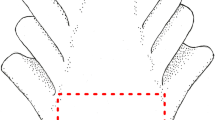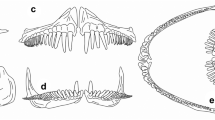Abstract
Elasmobranchs have an impressive range of highly specialized sensory systems shaped over 400 million years of evolution. The morphological analysis of oral papillae and denticle in elasmobranchs elucidates the biological role that these structures play during feeding and ventilation, bringing important descriptive information about ecological implications in an evolutionary context. The present study provides descriptions of the distribution patterns, histological characteristics and three-dimensional aspects of oral papillae and denticles in the lesser guitarfish Zapteryx brevirostris, through light microscopy and scanning electron microscopy. The presence of oral denticles in the oropharyngeal cavity suggests that this structure may have the following functions: protect against abrasion and parasites, increase the ability to grasp and hold prey and assist in reduction in hydrodynamic drag. The denticles in Z. brevirostris are similar to those found in pelagic sharks with forced ventilation (RAM). The structural conformity of denticles observed in the gill slits may facilitate water flow during prey grasp and food processing. This study supports the hypothesis that these structures may be an adaptive reflection shaped by feeding habits, capture strategies and processing prey.


Similar content being viewed by others
References
Atkinson CJL (2011) The gustatory system of elasmobranchs: morphology, distribution and development of oral papillae and oral denticles. Ph.D. Thesis. University of Queensland
Atkinson CJL, Collin SP (2010) Taste: Vertebrates. In: Breed MD, Moore J (eds) Encyclopedia of animal behavior, vol III. Academic Press, Oxford, pp 386–393
Atkinson CJL, Collin SP (2012) Structure and topographic distribution of oral denticles in elasmobranch fishes. Biol Bull 222:26–34
Bigelow HB, Schroeder WC (1953) Sawfishes, guitarfishes, skates and rays, vol 1 de Memoir. Sears Foundation for Marine Research, New Haven
Bornatowski H, Natascha W, Carmo WPD, Abilhoa V, Corrêa MFM (2014) Feeding comparisons of four batoids (Elasmobranchii) in coastal waters of southern Brazil. J Mar Biol Assoc UK 1:1–9
Ciena AP, Rangel BS, Bruno CEM, Miglino MA, Amorim AF, Rici REG, Watanabe I (2015) Morphological aspects of oral denticles in the Sharpnose shark Rhizoprionodon lalandii (Müller and Henle, 1839) (Elasmobranchii, Carcharhinidae). Anat Histol Embryol. doi:10.1111/ahe.12178
Collin SP (2012) The neuroecology of cartilaginous fishes: sensory strategies for survival. Brain Behav Evol 80:80–96
Compagno LJV (1977) Phyletic relationships of living sharks and rays. Am Zool 17:303–322
Compagno LJV (2005) Checklist of living chondrichthyes. In: Hamlett WC (ed) Reproductive biology and phylogeny of chondrichthyes. Sharks, batoids and chimaeras. Science Publishers Inc, Plymouth, pp 503–548
Cook MH, Neal HV (1921) Are the taste-buds of elasmobranchs endodermal in origin? J Comp Neurol 33:45–63
Daniel JF (1928) The elasmobranch fishes. University of California Press, Berkeley
Dean MN, Motta PJ (2004) Feeding behavior and kinematics of the lesser electric ray, Narcine brasiliensis. Zoology 107:171–189
Dean MN, Wilga CD, Summers AP (2005) Eating without hands or tongue: specialization, elaboration and the evolution of prey processing mechanisms in cartilaginous fishes. Biol Lett 1:357–361
Dean MN, Bizzarro JJ, Summers AP (2007) The evolution of cranial design, diet, and feeding mechanisms in batoid fishes. Integr Comp Biol 47:70–81
Deynat PP (2005) New data on the systematics and interrelationships of sawfishes (Elasmobranchii, Batoidea, Pristiformes). J Fish Biol 66:1447–1458
Fahrenholz C (1915) Über die Verbreitung von Zahnbildungen und Sinnesorganen im Vorderdarm der Selachier und ihre phylogenetische Beurteilung. Jena Z Naturwiss 53:389–444
Ferrando S, Gallus L, Gambardella C, Masini MA, Cutolo A, Vacchi M (2012) First detection of taste buds in a chimaeroid fish (Chondrichthyes: Holocephali) and their Gαi-like immunoreactivity. Neurosci Lett 517:98–101
Figueiredo JL (1977) Manual de peixes marinhos do Brasil—I. Introdução: cações, raias e quimeras. Museu de Zoologia, Universidade de São Paulo, São Paulo, pp 1–105
Gardiner JM, Hueter RE, Maruska KP, Sisneros JA, Casper BM, Mann DA, Demski LS (2012) Sensory physiology and behavior of elasmobranchs. In: Carrier JC, Musick JA, Heithaus MR (eds) Biology of sharks and their relatives, vol I, 2nd edn. CRC Press, Boca Raton, pp 349–401
Hart NS, Collin SP (2015) Sharks senses and shark repellents. Integr Zool 10:38–64
Hueter RE, Mann DA, Maruska KP, Sisneros JA, Demski LS (2004) Sensory biology of elasmobranchs. In: Carrier JC, Musick JA, Heithaus MR (eds) Biology of sharks and their relatives. CRC Press, Boca Raton, FL, pp 325–368
Imms AD (1905) On the oral and pharyngeal denticles of elasmobranch fishes. Proc Zool Soc Lond 1:41–49
Kotrschal KK (1996) Solitary chemosensory cells: Why do primary aquatic vertebrates need another taste system? Trends Ecol Evol 11:110–114
Lang A, Habegger ML, Motta P (2012) Shark skin drag reduction. In: Bhushan B (ed) Encyclopedia of nanotechnology, part 19. Springer, Berlin, pp 2394–2400
McEachran JD, Miyake T, Dunn KA (1996) Interrelationships of the batoid fishes (Chondrichthyes: Batoidea). In: Stiassny MLJ, Parenti LR, Johnson GD (eds) Interrelationships of fishes. Academic Press, New York, pp 63–84
Moss SA (1977) Feeding mechanisms in sharks. Am Zool 17:355–364
Müller J, Henle FGJ (1841) Systematische Beschreibung der Plagiostomen. Veit und Comp, Berlin, i–xxii, pp 103–200
Nelson GJ (1970) Pharyngeal denticles (placoid scales) of sharks, with notes on the dermal skeleton of vertebrates. Am Mus Novit 2415:1–26
Northcutt RG (2004) Taste buds: development and evolution. Brain Behav Evol 64:198–206
Pevsner RA (1976) Electron microscope study of the taste buds of Elasmobranches, Trzgongastinaca and Raja clavota. Tsitologiya 18:560–566
Reutter KW, Breipohl W, Bijvank GJ (1974) Taste bud types in fishes. Cell Tissue Res 153:151–165
Santos C, Cortellete GM, Araújo KCB, Spach HL (2006) Estrutura populacional da raia-viola Zapteryx brevirostris (Chondrichthyes, Rhinobatidae), na Plataforma adjacente à Baía de Paranaguá, PR. Acta Biol Leop 28:32–37
Shirai S (1996) Phylogenetic interrelationships of Neoselachian (Chondrichthyes: Euselachii). In: Stiassny MLJ, Parenti LR, Johnson GD (eds) Interrelationships of fishes. Academic Press, New York, pp 9–32
Thies D, Leidner A (2012) Sharks and guitarfishes (Elasmobranchii) from the Late Jurassic of Europe. Palaeodiversity 4:63–184
Todaro F (1872) Die Geschmacksorgane der Rochen. Zenthl med Wiss No 15: 227–229
Vooren CM, Lamónaca AF, Massa A, Hozbor N (2006) Zapteryx brevirostris. In: IUCN 2014. IUCN red list of threatened species. Version 2014.1. www.iucnredlist.org. Access 26 June 2014
Whitear M, Moate RM (1994a) Microanatomy of taste buds in the dogfish, Scyliorhinus canicula. J Submicrosc Cytol Pathol 26:357–367
Whitear M, Moate R (1994b) Chemosensory cells in the oral epithelium of Raja clavata (Chondrichthyes). J Zool (Lond) 232:295–312
Wilga CD, Motta PJ (1998) Feeding mechanism of the Atlantic guitarfish Rhinobatos lentiginosus: modulation of kinematic and motor activity. J Exp Biol 201:3167–3184
Wilga CD, Motta PJ, Sanford CP (2007) Evolution and ecology of feeding in elasmobranchs. Integr Comp Biol 47:55–69
Wueringer BE, Peverell SC, Seymour J, Squire SL, Kajiura SM, Collin SP (2011) Sensory systems in sawfishes. 1. The ampullae of Lorenzini. Brain Behav Evol 78:139–149
Acknowledgments
We would like to thank CNPq for Scientific initiation scholarship, CAPES for the Ph.D. scholarship, the postgraduate program of Department of Surgery, Faculty of the Veterinary Medicine and Animal Science from University of São Paulo and postgraduate program in Aquaculture and fishing in Instituto de Pesca. We also would like to thank MSc. Julia Whidden for reviewing the English, and the fisherman and professor Jorge Luís Santos for the donation of the animals.
Author information
Authors and Affiliations
Corresponding author
Additional information
Communicated by A. Schmidt-Rhaesa.
Rights and permissions
About this article
Cite this article
Rangel, B.d., Ciena, A.P., Wosnick, N. et al. Ecomorphology of oral papillae and denticles of Zapteryx brevirostris (Chondrichthyes, Rhinobatidae). Zoomorphology 135, 189–195 (2016). https://doi.org/10.1007/s00435-016-0304-0
Received:
Revised:
Accepted:
Published:
Issue Date:
DOI: https://doi.org/10.1007/s00435-016-0304-0




